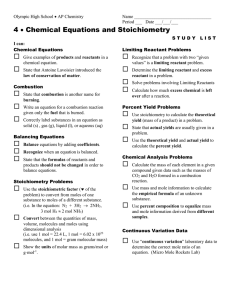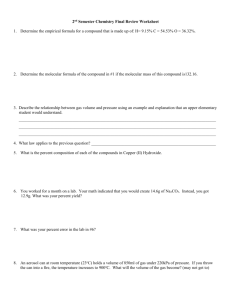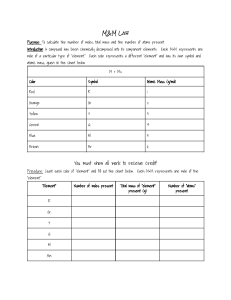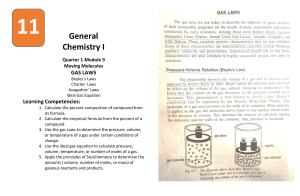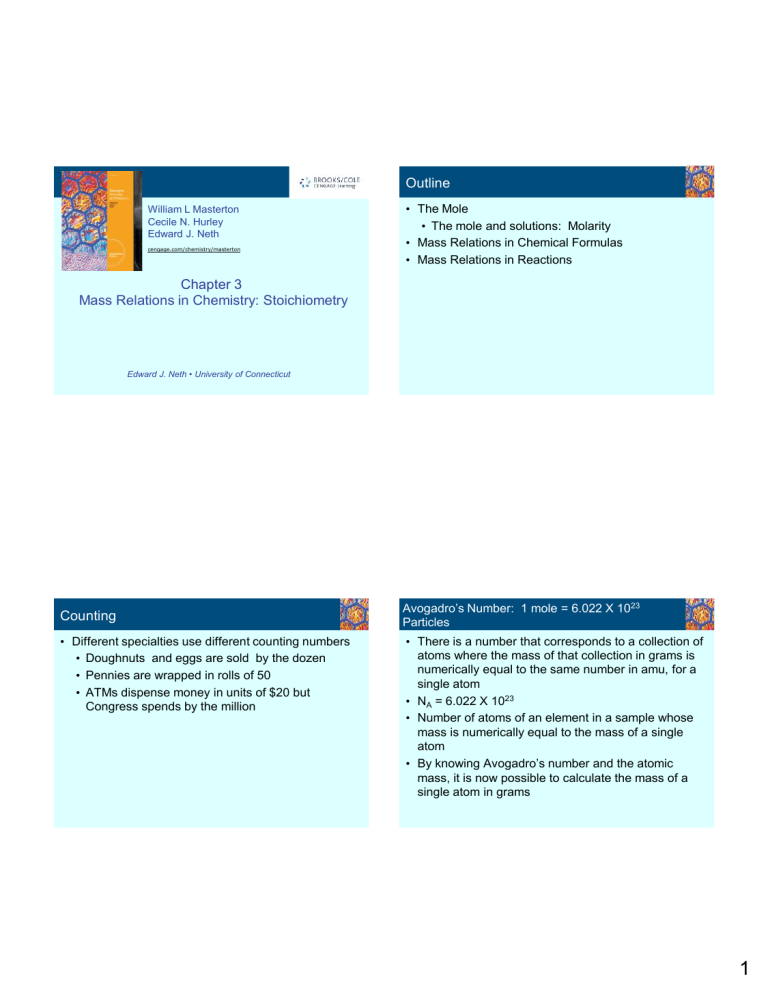
Outline William L Masterton Cecile N. Hurley Edward J. Neth cengage.com/chemistry/masterton • The Mole • The mole and solutions: Molarity • Mass Relations in Chemical Formulas • Mass Relations in Reactions Chapter 3 Mass Relations in Chemistry: Stoichiometry Edward J. Neth • University of Connecticut Counting • Different specialties use different counting numbers • Doughnuts and eggs are sold by the dozen • Pennies are wrapped in rolls of 50 • ATMs dispense money in units of $20 but Congress spends by the million Avogadro’s Number: 1 mole = 6.022 X 1023 Particles • There is a number that corresponds to a collection of atoms where the mass of that collection in grams is numerically equal to the same number in amu, for a single atom • NA = 6.022 X 1023 • Number of atoms of an element in a sample whose mass is numerically equal to the mass of a single atom • By knowing Avogadro’s number and the atomic mass, it is now possible to calculate the mass of a single atom in grams 1 The Mole Significance of the Mole • A mole is Avogadro’s number of items • The mole is a very large number • Avogadro’s number of pennies is enough to pay all the expenses of the United States for a billion years or more, without accounting for inflation • The molar mass • The molar mass, MM, in grams/mole, is numerically equal to the sum of the masses (in amu) of the atoms in the formula • By knowing Avogadro’s number and the atomic mass, it is now possible to calculate the mass of a single atom in grams Molar Masses of Some Substances Example 3.1 2 Example 3.1, (Cont’d) Example 3.1, (Cont’d) Example 3.1, (Cont’d) The Significance of the Mole • In the laboratory, substances are weighed on balances, in units of grams • The mole allows us to relate the number of grams of a substance to the number of atoms or molecules of a substance 3 Mole-Gram Conversions Figure 3.2 – Schema for Working With Moles and Masses • m = MM X n • m = mass • MM = molar mass • n = number of moles Reactions in the Laboratory Solute Concentrations - Molarity • Because water is common everywhere, most chemical reactions take place in aqueous solution • Water is called the universal solvent • Three common types of reactions in solution: • Definition of molarity • Molarity = moles of solute/liters of solution • Symbol is M • Square brackets are used to indicate concentration in M • Precipitation reactions • Acid-base reactions • Oxidation-reduction reactions • In Chapter 4, we will examine these reactions in detail – for now, we will look at the concentration of solutions in terms of their molarity • [Na+] = 1.0 M • Consider a solution prepared from 1.20 mol of substance A, diluted to a total volume of 2.50 L • Concentration is 1.20 mol/2.50 L or 0.480 M 4 Additivity Volumetric Glassware • Masses are additive; volumes are not • Volumetric pipets, burets and flasks are made so that they contain a known volume of liquid at a given temperature • Preparing solutions with concentrations in M involves using volumetric glassware • The total mass of a solution is the sum of the mass of the solute and the solvent • The total volume of a solution is not the sum of the volumes of the solute and solvent Figure 3.3 – Preparation of Molar Solution Molarity as a Conversion Factor • The molarity can be used to calculate • The number of moles of solute in a given volume of solution • The volume of solution containing a given number of moles of solute 5 Example 3.2 Example 3.2, (Cont’d) Example 3.2, (Cont’d) Dissolving Ionic Solids • When an ionic solid is dissolved in a solvent, the ions separate from each other • MgCl2 (s) → Mg2+ (aq) + 2 Cl- (aq) • The concentrations of ions are related to each other by the formula of the compound: • Molarity MgCl2 of = molarity of Mg2+ • Molarity of Cl- = 2 X molarity of MgCl2 • Total number of moles of ions per mole of MgCl2 is 3 6 Determining Moles of Ions Example 3.3 • By knowing the charge on ions, the formula of a compound can be quickly determined • The formula of the compound is key to determining the concentration of ions in solution Example 3.3, (Cont’d) Example 3.3, (Cont’d) 7 Chemical Formulas Mass Relations in Chemical Formulas • In Chapter 2, we learned that the chemical formula tells us the number of atoms of each element in a compound, whether that is a molecular compound or an ionic compound • We can now combine that knowledge with the knowledge of molar mass to begin relating elements by mass • Percent composition from formula • The percent composition of a compound is stated as then number of grams of each element in 100 g of the compound • By knowing the formula, the mass percent of each element can be readily calculated Example 3.4 Example 3.4, (Cont’d) 8 Chemical Analysis Simplest Formula from Chemical Analysis • Experimentation can give data that lead to the determination of the formula of a compound • Masses of elements in the compound • Mass percents of elements in the compound • Masses of products obtained from the reaction of a weighed sample of the compound • Often, the formula is not known, but data from chemical analysis is known • Amount of each element in grams • Can be used to determine the simplest formula Figure 3.5: Flowchart for Determining Simplest Formula Example 3.5 – Simplest Formula from Masses of Elements • Smallest whole-number ratio of atoms in a compound • H2O is the simplest formula and the molecular formula for water • HO is the simplest formula for hydrogen peroxide; the molecular formula is H2O2 9 Example 3.5, (Cont’d) Example 3.6 Example 3.6, (Cont’d) Molecular Formula from Simplest Formula • The relationship between simplest and molecular formula is a whole number • The whole number relates the molecular mass to the mass of the simplest formula as well 10 Example 3.7 – Simplest Formula from Mass Percents Example 3.7 – Simplest Formula from Mass Percents , Cont'd • When dealing with percentages, assume 100 g of the compound • By doing so, the unitless percentage becomes a meaningful mass Mass Relations in Reactions How are Equations Written? • Chemical equations represent chemical reactions • Reactants appear on the left • Products appear on the right • Equation must be balanced • We must know the reactants and the products for a reaction for which an equation is to be written • It is often necessary to do an experiment and an analysis to determine the products of a reaction • Determining the products is often time consuming and difficult • Number of atoms of each element on the left … • …equals the number of atoms of each element on the right 11 Writing Chemical Equations Example 3.8 1. Write a skeleton equation for the reaction. 2. Indicate the physical state of each reactant and product. 3. Balance the equation • Only the coefficients can be changed; subscripts are fixed by chemical nature of the reactants and products • It is best to balance atoms that appear only once on each side of the equation first Mass Relations from Equations Figure 3.8: Flowchart for Mole-Mass Calculations • The coefficients of a balanced equation represent the numbers of moles of reactants and products • 2 N2H4 (l) + N2O4 (l) → 3 N2 (g) + 4 H2O (l) • 2 mol N2H4 + 1 mol N2O4 → 3 mol N2 + 4 mol H2O 12 Example 3.9 Example 3.9, (Cont'd) Example 3.9, (Cont'd) Example 3.9, (Cont'd) 13 Limiting Reactant and Theoretical Yield Interpreting by Mass • 2 Sb (s) + 3 I2 (s) → 2 SbI3 (s) • Reactants • One mole Sb (243.6 g) • Three moles I2 (761.4 g) • Two moles SbI3 (1005.0 g) • All of the reactants are converted to product In the Laboratory Sb-I2 with a limiting reactant • Reactants are usually not mixed in exact ratios • An excess of one reactant is often used • Usually the less (or least) expensive reactant • One reactant will then limit the amount of product that will form • Suppose the mixture is • 3.00 mol Sb • 3.00 mol I2 • In this case • 1.00 mol Sb will be left over • 2.00 mol of Sb will be used • React with 3.00 mol I2 • Form 2.00 mol SbI3 14 Approach to Limiting Reactant Problems Example 3.10 1. Calculate the amount of product that will form if the first reactant were completely consumed. 2. Repeat the calculation for the second reactant in the same way. 3. Choose the smaller amount of product and relate it to the reactant that produced it. This is the limiting reactant and the resulting amount of product is the theoretical yield. 4. From the theoretical yield, determine how much of the reactant in excess is used, and subtract from the starting amount. Example 3.10, (Cont’d) Example 3.10, (Cont’d) 15 Verifying the Limiting Reactant The Pancake Analogy • Once the limiting reactant has completely reacted, there is no more left to react with the excess of the other reactant • Consider a recipe for pancakes. To make 16 pancakes, you need • 2 cups flour • 2 teaspoons baking powder • 2 eggs • 1 cup milk Pancakes Pancakes • Now start with • 2 cups flour • 2 teaspoons baking powder • 1 egg • 1 cup milk • It is clear that the egg will limit you to 8 pancakes and that you’ll have a cup of flour, a teaspoon of baking powder and a half a cup of milk left over • The egg is the limiting reactant and the theoretical yield is 8 pancakes 16 Experimental Yield • Experimental yields are always lower than theoretical yields • Some product is lost to competing reactions • Some product is lost to handling • Some product may be lost in separating it from the reaction mixture • The actual yield is the quantity of product you measure after you have done the reaction in the laboratory Example 3.11 Percent Yield • The percent yield is defined as % yield = actual yield X 100% theoretical yield Example 3.11, (Cont’d) 17 Key Concepts Key Concepts, (Cont’d) 1. Use molar mass to relate • Moles to mass • Moles in solution; molarity • Molecular formula to simplest formula 2. Use the formula of a compound to find percent composition or its equivalent. 3. Find the simplest formula from chemical analysis data. 4. Balance chemical equations by inspection 5. Use a balanced equation to • Relate masses of products and reactants • Find the limiting reactant, theoretical yield and percent yield 18


